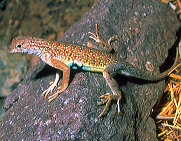 |
 | |
  | |
|
|
|
|
Coronado National Memorial
Reptiles
|
|
|
|
|
|
 |
 |
| (Photo by David Bly) | | Lesser Earless Lizard. |
 |
Coronado National Memorial supports a moderately diverse herpetofauna of seven amphibian and 36 reptile species. This diversity results from several factors including the fairly large elevation range and location in the overlap zones among the Chihuahuan and Sonoran Deserts, the Rocky Mountains, the Sierra Madre Occidental, and the Great Plains. The upper elevations of the Memorial contain many of the taxa with restricted U.S. ranges associated with the sky islands, including the mountain skink, Yarrow’s spiny lizard, bunch grass lizard, banded rock rattlesnake, Madrean alligator lizard, and Chihuahuan blackhead snake. The unique limestone areas provide rare habitat for barking frogs. Lower elevations include Great Plains species that are near the western limits of their range, such as the western hognose snake, the Texas blind snake, and the ornate box turtle, as well as a few Sonoran Desert species that are close to the eastern limit of their ranges, such as the Gila monster and Sonoran spotted whiptail.
|
|  |  |

|
 |
|
|
|
|
|
 |
|
Did You Know?
There are boundary markers along the US/Mexico Border. Coronado National Memorial has three boundary monuments, 100, 101, and 102. The markers are placed within line of site. They begin in El Paso, Texas and end in San Diego, California.
|
|
|
|
Last Updated: August 02, 2006 at 14:37 EST |






